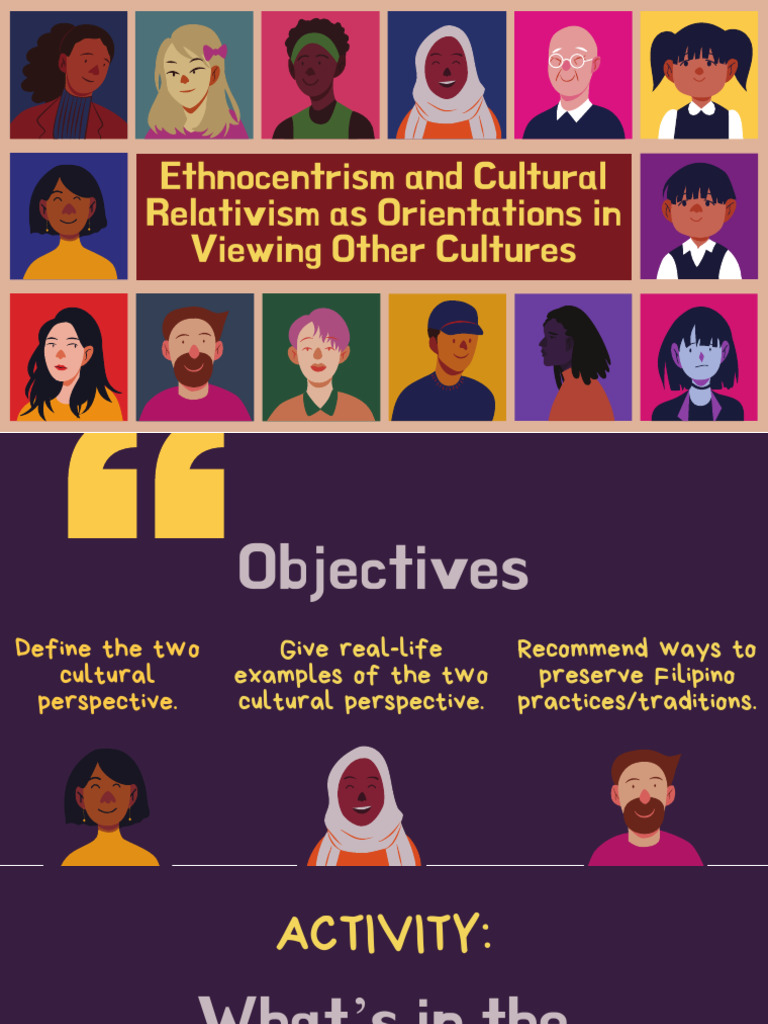In the intricate tapestry of cultural discourse, two seminal concepts emerge as pivotal in understanding human interaction and societal norms: ethnocentrism and cultural relativism. Both represent fundamental frameworks through which individuals and societies perceive and engage with the multitude of cultural expressions present in the global arena. To dissect these concepts effectively, it is necessary to explore their meanings, characteristics, and implications, particularly in relation to visual representations that may encapsulate these ideologies.
Ethnocentrism is the proclivity to evaluate other cultures through the lens of one’s own, often leading to the presumption of superiority of one’s cultural norms and values. Ethnocentrism can engender a narrow worldview where individuals may view their cultural practices as the standard or ideal. It fosters an environment where misunderstandings and misinterpretations can proliferate. For instance, in visual art or images depicting cultural practices, ethnocentrism might manifest as an artist portraying a ritual from a distant culture as inherently ‘strange’ or ‘barbaric’. Such portrayals not only misrepresent the culture but also reinforce stereotypes, perpetuating a cycle of misunderstanding.
Conversely, cultural relativism posits that cultural beliefs and practices should be understood in their own context, without the bias of external judgments. This perspective encourages individuals to appreciate the diversity of cultural expressions and recognizes that no culture is superior to another. In imagery, cultural relativism might be represented by photographs or illustrations that celebrate rather than critique different cultural practices, highlighting the beauty and significance of diverse traditions.
When analyzing pictures or visual representations for the traits of ethnocentrism versus cultural relativism, one can expect to encounter various narrative techniques. Ethnocentric images may rely on stark contrasts and exaggerated differences, often caricaturing the subject culture. For example, photographs depicting cultural attire may emphasize oddities while neglecting the underlying significance or traditional context. Furthermore, ethnocentric portrayals might invoke a judgemental tone, framing the subjects in a manner that suggests moral or behavioral deficits due to cultural differences.
On the other hand, images illustrating cultural relativism typically portray subjects with a sense of dignity and respect. These pictures may capture the vibrancy of cultural celebrations, arts, and community interactions, inviting viewers to partake in a broader understanding of the human experience. They often invite the viewer to engage emotionally and intellectually, challenging preconceived notions and biases. Such images foster empathy and recognition of shared human experiences despite apparent differences.
The interplay between these two concepts extends beyond the realm of art into the media, literature, and social discourse. For instance, a news article with an accompanying image that depicts a cultural event might present it from an ethnocentric perspective by focusing solely on sensational aspects. Alternatively, a comparable article that respects and contextualizes the event, with imagery that emphasizes its significance within that culture, would exemplify cultural relativism.
A deeper exploration of the implications of these concepts reveals their effects on global interactions and relationships. Ethnocentrism can lead to xenophobia, discrimination, and cultural imperialism, where dominant cultures impose their norms on others. This hierarchical view can precipitate social tensions and conflict, as marginalized cultures struggle to assert their identities against a backdrop of oppression. Consequently, the ethnocentric viewpoint can inhibit cross-cultural dialogue and understanding, stifling the potential for collaborative problem-solving in a world rife with transnational challenges.
In stark contrast, cultural relativism encourages dialogue and promotes coexistence by recognizing the intrinsic value of all cultural practices. This perspective is particularly relevant in the context of globalization, where cultural exchanges are commonplace. Cultural relativism posits that diversity should not only be preserved but celebrated, paving the way for more inclusive policies and practices. Through educational programs and intercultural communication initiatives, cultural relativism can mitigate stereotypes and foster mutual respect.
In academia, the discourse surrounding these concepts is crucial for sociocultural research, anthropology, and psychology. Scholars often utilize ethnographic methodologies to explore cultural practices without imposing their biases. Images used in scholarly contexts aim to capture the essence of cultural experiences authentically, embodying the principles of cultural relativism while advancing the understanding of ethnocentrism’s impacts.
Moreover, in an age defined by digital media, the proliferation of content depicting cultural phenomena necessitates a discerning eye. Social media is replete with visual content that may oscillate between these two ideologies. Users must navigate these representations critically, acknowledging the potential implications of an ethnocentric narrative while embracing the richness of cultural relativity.
Ultimately, the images we encounter can profoundly influence our perceptions and attitudes towards other cultures. It is imperative to cultivate awareness about the characteristics of ethnocentrism and cultural relativism in visual content. By advocating for and supporting representations that reflect a cultural relativistic viewpoint, individuals can contribute to a more nuanced understanding of the world’s cultural diversity.
In conclusion, whether through the lens of artistic expression or in everyday media, the visual portrayal of cultures can affirm or challenge ethnocentrism and cultural relativism. Recognizing these competing ideologies not only enhances our critical thinking but also enriches our collective experience of humanity. Through informed engagement with diverse visual narratives, we can better appreciate the complexity of cultural identities and foster an environment conducive to understanding and cooperation.
